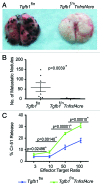Tgf-β1 produced by activated CD4(+) T Cells Antagonizes T Cell Surveillance of Tumor Development
- PMID: 22720237
- PMCID: PMC3376999
- DOI: 10.4161/onci.1.2.18481
Tgf-β1 produced by activated CD4(+) T Cells Antagonizes T Cell Surveillance of Tumor Development
Abstract
TGFβ1 is a regulatory cytokine with a crucial function in the control of T cell tolerance to tumors. Our recent study revealed that T cell-produced TGFβ1 is essential for inhibiting cytotoxic T cell responses to tumors. However, the exact TGFβ1-producing T cell subset required for tumor immune evasion remains unknown. Here we showed that deletion of TGFβ1 from CD8(+) T cells or Foxp3(+) regulatory T (Treg) cells did not protect mice against transplanted tumors. However, absence of TGFβ1 produced by activated CD4(+) T cells and Treg cells inhibited tumor growth, and protected mice from spontaneous prostate cancer. These findings suggest that TGFβ1 produced by activated CD4(+) T cells is a necessary requirement for tumor evasion from immunosurveillance.
Figures




Similar articles
-
iNOS expression in CD4+ T cells limits Treg induction by repressing TGFβ1: combined iNOS inhibition and Treg depletion unmask endogenous antitumor immunity.Clin Cancer Res. 2014 Dec 15;20(24):6439-51. doi: 10.1158/1078-0432.CCR-13-3409. Epub 2014 Oct 2. Clin Cancer Res. 2014. PMID: 25278453
-
Providence of the CD25+ KIR+ CD127- FOXP3- CD8+ T-cell subset determines the dynamics of tumor immune surveillance.Immunol Cell Biol. 2018 Nov;96(10):1035-1048. doi: 10.1111/imcb.12166. Epub 2018 Aug 17. Immunol Cell Biol. 2018. PMID: 29768737
-
T cell surveillance of oncogene-induced prostate cancer is impeded by T cell-derived TGF-β1 cytokine.Immunity. 2011 Jul 22;35(1):123-34. doi: 10.1016/j.immuni.2011.04.019. Epub 2011 Jul 14. Immunity. 2011. PMID: 21757379 Free PMC article.
-
Overview of LAG-3-Expressing, IL-10-Producing Regulatory T Cells.Curr Top Microbiol Immunol. 2017;410:29-45. doi: 10.1007/82_2017_59. Curr Top Microbiol Immunol. 2017. PMID: 28929191 Review.
-
Thymic commitment of regulatory T cells is a pathway of TCR-dependent selection that isolates repertoires undergoing positive or negative selection.Curr Top Microbiol Immunol. 2005;293:43-71. doi: 10.1007/3-540-27702-1_3. Curr Top Microbiol Immunol. 2005. PMID: 15981475 Review.
Cited by
-
TGF-β suppresses type 2 immunity to cancer.Nature. 2020 Nov;587(7832):115-120. doi: 10.1038/s41586-020-2836-1. Epub 2020 Oct 21. Nature. 2020. PMID: 33087928 Free PMC article.
-
Liver-infiltrating CD11b-CD27- NK subsets account for NK-cell dysfunction in patients with hepatocellular carcinoma and are associated with tumor progression.Cell Mol Immunol. 2017 Oct;14(10):819-829. doi: 10.1038/cmi.2016.28. Epub 2016 Jun 20. Cell Mol Immunol. 2017. PMID: 27321064 Free PMC article.
-
TGFβ control of immune responses in cancer: a holistic immuno-oncology perspective.Nat Rev Immunol. 2023 Jun;23(6):346-362. doi: 10.1038/s41577-022-00796-z. Epub 2022 Nov 15. Nat Rev Immunol. 2023. PMID: 36380023 Free PMC article. Review.
-
Molecular and therapeutic effect of CRISPR in treating cancer.Med Oncol. 2023 Jan 17;40(2):81. doi: 10.1007/s12032-022-01930-6. Med Oncol. 2023. Retraction in: Med Oncol. 2025 Mar 24;42(5):132. doi: 10.1007/s12032-025-02692-7. PMID: 36650384 Free PMC article. Retracted. Review.
-
Immunity beyond cancer cells: perspective from tumor tissue.Trends Cancer. 2021 Nov;7(11):1010-1019. doi: 10.1016/j.trecan.2021.06.007. Epub 2021 Jul 22. Trends Cancer. 2021. PMID: 34305041 Free PMC article. Review.
References
-
- Burnet FM. The concept of immunological surveillance. Prog Exp Tumor Res. 1970;13:1–27. - PubMed
Publication types
LinkOut - more resources
Full Text Sources
Other Literature Sources
Research Materials
